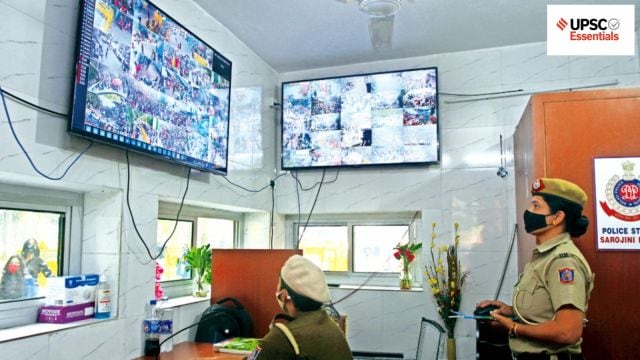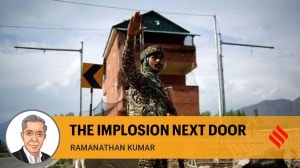UPSC Essentials | Mains answer practice — GS 3 : Questions on use of technology in law enforcement and Genome India Project (Week 98)
Are you preparing for UPSC CSE 2025? Here are questions from GS paper 3 for this week with essential points as the fodder for your answers. Do not miss points to ponder and answer in the comment box below.
 Attempt a question on the use of technology in law enforcement in today's answer writing practice. (File Image)
Attempt a question on the use of technology in law enforcement in today's answer writing practice. (File Image)UPSC Essentials brings to you its initiative for the practice of Mains answer writing. It covers essential topics of static and dynamic parts of the UPSC Civil Services syllabus covered under various GS papers. This answer-writing practice is designed to help you as a value addition to your UPSC CSE Mains. Attempt today’s answer writing on questions related to topics of GS-3 to check your progress.
🚨 Click Here to read the UPSC Essentials magazine for March 2025. Share your views and suggestions in the comment box or at manas.srivastava@indianexpress.com🚨
QUESTION 1
The Genome India Project shows the use of technology in government to improve public health and scientific research. Critically examine the goals, implementation challenges, and potential consequences of such technology-driven efforts.
QUESTION 2
The GP-DRASTI initiative shows the use of technology in law enforcement to improve public safety and efficiency. Critically examine the goals, implementation obstacles, and potential implications in the context of Indian policing.
General points on the structure of the answers
Introduction
— The introduction of the answer is essential and should be restricted to 3-5 lines. Remember, a one-liner is not a standard introduction.
— It may consist of basic information by giving some definitions from the trusted source and authentic facts.
Body
— It is the central part of the answer and one should understand the demand of the question to provide rich content.
— The answer must be preferably written as a mix of points and short paragraphs rather than using long paragraphs or just points.
— Using facts from authentic government sources makes your answer more comprehensive. Analysis is important based on the demand of the question, but do not over analyse.
— Underlining keywords gives you an edge over other candidates and enhances presentation of the answer.
— Using flowcharts/tree-diagram in the answers saves much time and boosts your score. However, it should be used logically and only where it is required.
Way forward/ conclusion
— The ending of the answer should be on a positive note and it should have a forward-looking approach. However, if you feel that an important problem must be highlighted, you may add it in your conclusion. Try not to repeat any point from body or introduction.
— You may use the findings of reports or surveys conducted at national and international levels, quotes etc. in your answers.
Self Evaluation
— It is the most important part of our Mains answer writing practice. UPSC Essentials will provide some guiding points or ideas as a thought process that will help you to evaluate your answers.
THOUGHT PROCESS
You may enrich your answers by some of the following points
QUESTION 1: The Genome India Project shows the use of technology in government to improve public health and scientific research. Critically examine the goals, implementation challenges, and potential consequences of such technology-driven efforts.
Note: This is not a model answer. It only provides you with thought process which you may incorporate into the answers.
Introduction:
— Genome India is a groundbreaking scientific effort supported by the Department of Biotechnology, Ministry of Science and Technology, Government of India.
— Genome India’s major goal is to create a comprehensive library of genetic variations that reflect the unique diversity of the Indian people.
Body:
You may incorporate some of the following points in your answer:
— The first phase of India’s ambitious effort to map its people’s genetic variety has been completed, and the data are available for use. The Genome India Project (GIP) has collected the whole gene sequences of 10,000 people from 83 ethnic groupings. This database will eventually be greatly enlarged, but it is currently a valuable resource with important implications for health and medicine, as well as other fields.
— The genome database will enable personalised medicine, as well as faster and more efficient diagnostics. It will also reveal information about the evolution and migrations of population groups in India, as well as how they have adapted to the local climate and environment.
— Most importantly, the genome database would benefit human health. Individual blood samples were used to prepare the genome sequences.
— The full genome of an individual is the precise order in which four nucleotide molecules in human DNA are arranged in an approximately three-billion-long sequence. These four nucleotide molecules — adenine, thymine, cytosine, and guanine, or simply A, T, C, and G — combine with a phosphate molecule and a sugar molecule to form the long double-helix DNA strands that serve as the individual’s genetic blueprint.
— More than 99.9% of the nucleotide sequence is identical in all humans. It is the 0.1% difference that distinguishes a person, not only in physical appearance (height or facial features), but also in behavioural tendencies.
Conclusion:
— The GIP can also help to improve our understanding of population history and evolution. The germline sequences are what an individual inherits from their parents. Studying the sequences can help determine ancestry and parenthood. Genetic variants that are more common in the population are likely to have emerged much earlier, whereas those identified in only a few people are more likely to be recent occurrences.
— Scientists may learn a lot about the history and development of populations by comparing the genomes of a large number of people across multiple generations and from various ethnic, geographical, and linguistic backgrounds. Scientists, for example, can gather data about how populations moved from one location to another, socialised and intermarried with other groups, and adapted to local surroundings. This type of information is extremely useful in resolving the identification issue — who we are and where we came from — which is an insatiable curiosity among humans.
— Do you know: Germline sequences are derived from white blood cells, which are better at retaining the original sequence during cell division. Among other things, the unique components of this germline sequence may provide information about an individual’s proclivity for specific diseases or disorders. It can reveal not just why a specific person has a problem, but also why certain treatment options may be ineffective in this circumstance.
(Source: Why Genome India Project matters by Amitabh Sinha)
Points to Ponder
Read more about Germline sequences
Read more about Genome India Project
Related Previous Year Questions
Why is nanotechnology one of the key technologies of the 21st century? Describe the salient features of Indian Government’s Mission on Nanoscience and Technology and the scope of its application in the development process of the country. (2016)
Stem cell therapy is gaining popularity in India to treat a wide variety of medical conditions including Leukaemia, Thalassemia, damaged cornea and several burns. Describe briefly what stem cell therapy is and what advantages it has over other treatments? (2017)
QUESTION 2: The GP-DRASTI initiative shows the use of technology in law enforcement to improve public safety and efficiency. Critically examine the goals, implementation obstacles, and potential implications in the context of Indian policing.
Note: This is not a model answer. It only provides you with thought process which you may incorporate into the answers.
Introduction:
— GP-DRASTI went live just a month after gang violence was recorded in Ahmedabad’s Vastral, when miscreants attacked pedestrians and damaged automobiles. The incident occurred after reports of stabbings in Vadodara, sword duels in Surat, bootlegging activities in Ahmedabad, and drive-by gang shootings in Rajkot.
— When an incident occurs anywhere in Gujarat, the police’s response time and quality are critical. The arrangement of PCR vehicles is currently accessible. However, they take some time to get to the scene of the incident. Gujarat Police have opted to employ drones to save time and take prompt action.
Body:
You may incorporate some of the following points in your answer:
How does it work?
— When the control room receives a call, they will notify not just the local police but also the drone base station via the same channel, ensuring that both the air and ground units are dispatched simultaneously. In the trial programme, the drone arrived in less than half the time as the ground teams.
— Real-time video footage sent straight to the base station would allow administrators to determine whether a situation was worsening and request additional ground forces to be deployed.
— The initiative is primarily intended for 33 police station jurisdictions in four cities that are hotspots for “body-related” offences like as assault, aggravated assault, rioting, unlawful assembly, street violence, displays of weapons, mob lynchings, and so on.
Potential implications of such technology-driven efforts in the context of Indian policing
— The quadcopter drones will fly at an operable flight ceiling of 120 meters above ground level.
— The flight time of 45 minutes is sufficient. Replacement drones from other police stations can be sent in turn if a broad area needs to be covered. The drone can be operated from a distance of 4 kilometres, but no police station’s jurisdiction extends over such a broad area. To keep within range, the drone base station will be strategically situated.
— The drone cameras can zoom up to 1 km and have been tested successfully at a visual range of 700 metres, producing high-quality footage. The main camera has built-in night vision, thus switching between day and night modes requires no additional payload.
— The controller can also direct the drone to follow a specific target, either for surveillance or to intercept with ground personnel. The drone can see through soft obstacles such as trees and bushes, but if a target goes behind a solid structure, it must be re-acquired by relocating the drone.
Conclusion:
— Gujarat police have used quadcopter drones to track down fugitives and find missing children as part of the GP-DRASTI (Drone Response and Aerial Surveillance Tactical Interventions) program.
— The cameras can also capture high-definition facial details. This aerial ID technology will come in handy for identifying persons in crowds and in circumstances where a big number of people are accused of criminal activity.
(Source: What is the Gujarat police’s GP-DRASTI drone program?)
Points to Ponder
Other initiatives related to Drones
Use of technology in law enforcement
Related Previous Year Questions
The use of unmanned aerial vehicles (UAVs) by our adversaries across the borders to ferry arms/ammunitions, drugs, etc., is a serious threat to the internal security. Comment on the measures being taken to tackle this threat. (2023)
Mob violence is emerging as a serious law and order problem in India. By giving suitable examples, analyze the causes and consequences of such violence. (2017)
Previous Mains Answer Practice
UPSC Essentials: Mains answer practice — GS 3 (Week 96)
UPSC Essentials: Mains answer practice — GS 3 (Week 97)
UPSC Essentials: Mains answer practice — GS 2 (Week 96)
UPSC Essentials: Mains answer practice — GS 2 (Week 97)
UPSC Essentials: Mains answer practice — GS 1 (Week 97)
UPSC Essentials: Mains answer practice — GS 1 (Week 96)
Subscribe to our UPSC newsletter and stay updated with the news cues from the past week.
Stay updated with the latest UPSC articles by joining our Telegram channel – IndianExpress UPSC Hub, and follow us on Instagram and X.
Must Read



Buzzing Now


Apr 27: Latest News
- 01
- 02
- 03
- 04
- 05





















